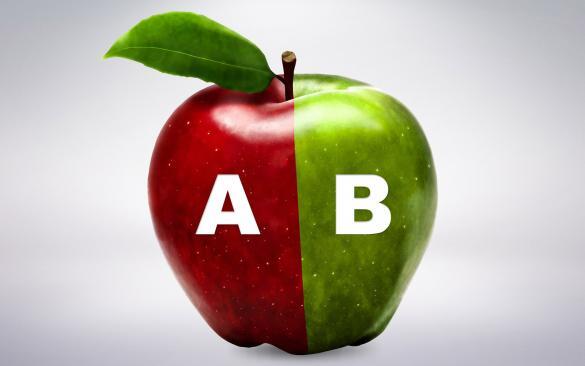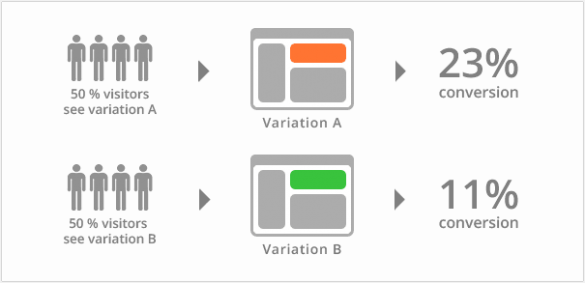Are you trying to increase your profits by making some changes to your website? Are you worried that the changes might actually lower your conversion rates and therefore profits? A lot of us delay making changes due to endless second guessing or long staff meetings, wondering if a change will be a beneficial one. This is where A/B testing comes in. It provides all the crucial information to give us confidence and help us make firm decisions.

Just like any other website owner, you probably want your visitors to perform some kind of an action. Regardless of the type of website, it should successfully motivate the visitors to take actions which will boost your business results. In other words, you need a higher conversion rate.
People’s wants and needs are constantly changing, so if you want to keep a high conversion rate you have to make frequent website changes. Moreover, you have to make sure that these changes will really improve your website, and there is no one better to tell you if an improvement works then the visitors themselves. Their actions will tell you everything you need to know about what works, and what doesn’t. But how do you measure and interpret their actions? The simplest way to do this is through the use of A/B testing.
What is A/B testing?
A/B testing is also known as split testing. It is the simplest and most effective way of testing any changes that you want to implement on your website. In fact, A/B testing helps you to measure the effectiveness of any change or variable on your website.
A/B testing allows you to check if a change will bring higher conversion rates before you make that change a permanent feature of your website.

There are two types of A/B testing technology
- Traditional A/B testing simply redirects a percentage of visitors to a different webpage. This means that visitors from group B will see a different internet address than group A.
- More complex A/B tools work by dynamically swapping out certain variables on a page. This means that both group A and B are both watching the same page (same internet address), they just see different things on that page.
- There is also something called “multi-variate” testing where multiple elements on the page are being randomly replaced with one of many different pre-defined alternative elements. This is not A/B testing, and unless your sample sizes run in the millions, you’ll want to stick to A/B testing.
If you need help with choosing the right type of A/B testing, you can always ask for professional help.
A lot of scenarios call for variable-based A/B testing technology
It might be that you are testing a different wording for the CTA (call to action) on your homepage. It might be that you are testing if a different website design keeps people engaged for longer. You might even be testing different colors for the headlines on the “sales page” for your product.
If you are testing a different look and you use a CMS (such as WordPress), you might use a “theme splitter plugin”. This tool will show a different “look” to different visitors. They see the same website with the same content and the same pages at the same URLs, it’s just that the overall website design is different.
If you want to test a small change such as a different headline in the middle of a big page, you might use a split-testing tool that only switches out that headline. All visitors see the same page at the same internet address, but for some of them (group B), the split-tester changes the headline on the fly so they see a different one.
Then there’s also more traditional A/B testing
If you want to test two completely different versions of something, you might want to use traditional A/B testing based on redirects. This type of testing can also be seen as real time focus-group testing. Let’s say that you want to test two different homepages. You can tell your split-tester to redirect a percentage of homepage visitors to an alternate homepage. Part of your website visitors will be redirected to the new version of the homepage, while the others will land on your current homepage. Therefore you can measure the performance of both (A and B) versions and get a clear perspective if you should make changes or not.
If the new version proves to be better you can make it new default homepage. Otherwise, if the new version under-performs, you simply end the A/B test and keep the old homepage. Until you come up with another idea to test that is.
Again, if you need help choosing and setting up a split-testing tool, professional help is just a click away.
Why should you use A/B testing?
The results of A/B testing are always clear – the option that brings higher conversion rates or better metrics will pass the test. Split testing will always point out the website version that brings more clicks, downloads or purchases, and longer visits. All of this will help end all your worries and hesitations. Thanks to A/B testing you will be able to get more out of your existing traffic.
If the main role of your homepage is to get people to the contact page, then the test is simple. The homepage version that gets more people to the contact us page, is the winner. If you are testing two sales pages, well the sales page that produces more sales is the winner.
It’s pretty simple really. Testing your website will help you get a clearer perspective on your visitors’ behavior. It gives you an opportunity to make decisions based on quantitative data and that leaves no space for misinterpretations.

Using A/B testing you will save time on team meetings and debates whether your website needs a change and how it can be improved. You will leave the final word to your site visitors and enjoy the benefits. Optimizing your website through split testing will bring you increased revenue, registrations, downloads, or sales – whatever you are going for.
What can you use A/B testing for?
With A/B you can test any aspect of the website that affects visitors’ behavior. It all depends on what your goals are. Therefore, you have to decide on particular elements that you want to improve before getting started with A/B testing.
These are some common elements that people do A/B testing with
| – Website layout and style; – Colors, images, and sales graphics; – Headlines, sub-headlines, product descriptions, and sales copy; |
– Navigation; – Testimonials; – Calls to action; – Links and buttons; – Product pricing; |
How do you prepare for A/B testing?
Split testing is considered to be the most scientific strategy for measuring and improving conversion rates. It gives measurable results gathered in a real time environment. Therefore, it’s best if you use scientific methods for preparing your A/B testing set up as well.
Before you start the tests, you should ask yourself why your website has lower conversion rates than expected. In order to get realistic answers on the behavior of your visitors, you can use Google Analytics.
Based on the answers gathered, you will be able to create a hypothesis. Here are some examples.
– “Improving the website navigation will increase the conversion rate.”
– “Adding more striking buttons will increase downloads/purchases.”
– “Lowering product pricing/increasing the number of promotions will improve conversion rates.”
– “Reorganizing the website layout will reduce bounce rates.”
As soon as you define your hypothesis, you should make estimates on the number of visitors and days needed to perform the test. When you get a clear perspective on your testing needs, you need to make the B version of the thing being tested. If you’re merely testing different “buy buttons”, you need to prepare those new graphics and plug in the html in your variable testing tool. If you’re testing two completely different page versions, you need to prepare page B and publish it separately.
In order to gather measurable results, you will have to set up a conversion goal or have a way to measure different metrics. When testing conversions, usually, there is a page that represents “success”. For example, if you are testing your download or purchase buttons, the visitor reaching the “thank you” page represents “success”. So you need to set up these tools to tell you which version gets more people over to the thank you page.

Whatever conversion goal you choose, the A/B testing tool will record a “successful conversion” every time the action is performed by the visitor, whether it is simply staying on the page longer, or visiting a “thank you page”. After the test reaches a decent sample size, you can check the results. You will see which version drove higher conversion rates and you can then confidently use this version as the default version that all visitors see.
You can do as many A/B tests as you want. In fact, it’s highly recommended to use split testing on regular basis. Regular testing of your website changes will significantly increase conversion rates and help you achieve your goals.





